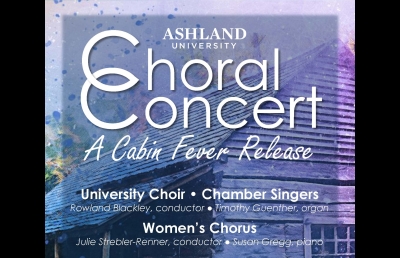Jack and Deb Miller Chapel to host choral concert on St. Patrick’s Day

March 15, 2019
On St. Patrick’s Day, March 17, a day of wearing green and celebrating one’s inner Irish, the Ashland University campus will also be welcoming a day of music.
The Jack and Deb Miller Chapel will play host to a vocal ensemble with performances by three groups at 4 p.m. The Ashland University Choir, conducted by Dr. Rowland Blackley; the Chamber Singers, also conducted by Blackley; and the Women’s Chorus, led by Ashland alum Julie Strebler-Renner.
The selections that the ensemble will be performing are a mix of madrigals, spirituals, folk songs and performance of Franz Joseph Haydn’s “Little Organ Mass.”
Some of the madrigals will be juxtaposed with Elizabethan text from the 16th century being performed to 20th-century music.
“Even though the performance is on St. Patrick’s Day, there will be no Irish music,” Blackley said with a laugh. “It was just a complete coincidence that it ended up being on that day. I did not plan on it.”
As the director of Choral Activities, Blackley is used to the amount of preparation that goes into directing an ensemble like this.
“Most of the work, not that it’s not fun, is the daily rehearsal,” Blackley said. “In the concert, the fun part is trying to draw that little bit of extra out of the singers because they are focused and ready to share that music with the audience.”
One part of the show that Blackley is looking forward to the most is the performance of junior Rebecca Young, who is performing her first “real” solo of her college career.
Young will be performing a part of the “Little Organ Mass” entitled the “Benedictus – Missa Brevis Sancti Johannis Mass” by Haydn.
“It’s a little bit stressful because it’s a difficult piece,” Young said. “Dr. Blackley assigned me the piece at the beginning of last semester to learn because it’s difficult and nothing I’ve ever done before. At the same time, I’m privileged and honored that he chose me to do it. I’m very excited.”
When preparing to do a solo, Young said that the most difficult part is that she’s learning the piece alone with the orchestra accompaniment; that part comes later during the rehearsals.
“Without the accompaniment being there from the beginning, there is a feeling-out process that takes a while to create familiarity,” Young said.
The ensemble is free and open to the public.

